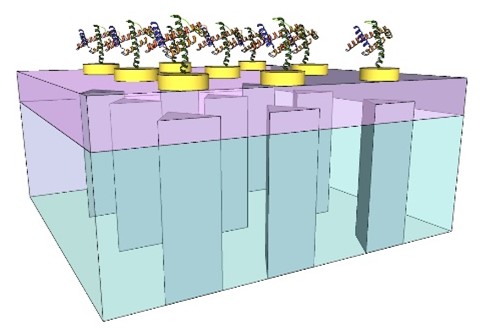Home > News & Events > Going nano for maximum impact

A new way to solve a major problem in miniaturised sensors is at hand.
A major stumbling block in the race to provide comfortable and effective health monitoring is the need for miniaturisation of a large number of components, and to integrate them into a stand-alone sensing system. The finished device needs to still be sensitive enough to measure the small but significant changes that can indicate something important.
For the huge number of systems that measure changes in light to track health, this miniaturisation is particularly challenging given that the core components are typically some sort of light source or lamp, and a sensor that can detect light returning from the sample. Both are traditionally relatively large and require bulky cooling systems to ensure the accuracy of the overall system.
A team at ANU, led by Professor Lan Fu has harnessed the unique properties of nanowires and coupled them with a metasurface to create a system that can detect changes in refractive index in a device a fraction of the size currently available.
Her ANFF enabled technology uses controlled growth of nanowire arrays with uniform triangular shapes to create an LED capable of producing infrared light. This LED nanowire array is then topped by a fabricated metasurface. The light emission from the nanowire LEDs resonates with the metasurface resulting in a device that is 10,000 times smaller than similar current approaches and that can also tune the properties of the output light.
Biosensing occurs when specific markers or biomolecules bind to the metasurface, which changes the refractive index of the material at that point – this can be detected with ease resulting in a measurement that can be used to monitor a variety of health conditions.
This technology has an impressive potential to improve efficiencies in a number of applications. Nanowires are promising building blocks for the next generation nanoscale semiconductor electronics, photonics and optoelectronic devices. Their nanoscale one-dimensional geometry leads to novel optical and electrical properties desirable for applications such as LEDs, lasers, photodetectors, solar cells, and biosensors.
“Not only do these nanowires act as important foundations for high-performance active devices, but they also have the great potential for development of the miniaturised photonic systems such as the nanowire LED/Metasurface integrated biosensors,” explained Professor Lan Fu.
The ability of groups like these to take theoretical simulations and transform them into testable devices is a core function of the ANFF. The availability of the expertise and the equipment required to bring this research towards a fruitful outcome benefits all sectors of the Australian research and development ecosystem.
This work is supported by the ARC Centre of Excellence in Transformative Meta-optical Systems (TMOS) and aligns with the ANU Grand Challenge, Our Health in our Hands providing a holistic approach to understanding one’s own health through new science and technology.

